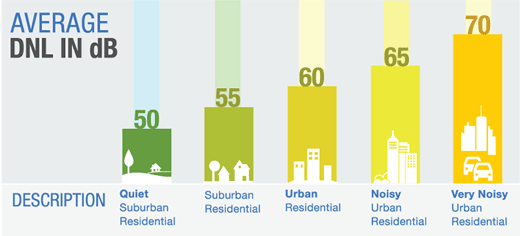Community Response to Noise
Noise comes from many sources, not just aviation. As a result, the level of noise someone experiences day to day can depend on many factors. Noise in small suburban areas compared with busy urban centers may be very different and result in various types of challenges when looking to address aircraft noise.
DNL Values In Residential Areas

Source: Federal Agency Review of Selected Airport Noise Analysis Issues, Federal Interagency Committee on Noise, August 1992.
There are also numerous factors that determine how much aircraft noise is experienced on the ground:
- What model aircraft and what type of engines are being used for each flight?
- Are the aircraft taking off or landing?
- What is the flight path of the flights going overhead?
- How quickly does each plane ascend and descend?
- Is the aircraft operating at full power or partial power?
Noise experienced on the ground also depends on flight schedules, which can vary depending on the time of day, season of the year, or other operational factors. Weather also plays a large role, since sound attenuates (dissipates) differently depending on weather conditions (wind speed and direction, temperature, etc.).
Determining how to capture the effects of all these considerations can become extremely complex very quickly. A house one-half mile north of an airport may experience very different aircraft noise exposure over a day, week, and year than a school one mile south of that airport.
Using the Day-Night Average Sound Level
To describe the effects of environmental noise in a simple, uniform and appropriate way, the day-night average sound level (DNL) noise metric is used. DNL is a metric that reflects a person's cumulative exposure to sound over a 24-hour period, expressed as the noise level for the average day of the year on the basis of annual aircraft operations. All the factors described above, plus many others, are calculated for the entire area surrounding an airport. An entire year's worth of flights from the airport are examined using sophisticated aircraft noise modeling programs. Every aircraft's weight, trajectory, flight path, and many other characteristics are input into the program. To account for a higher sensitivity to noise exposure at night (occurring between 10 p.m. and 7 a.m.), DNL calculations add a ten times weighting for each nighttime flight, equivalent to each nighttime event being measured as if ten daytime events had occurred: because of the logarithmic scale, this is equivalent to each nighttime event receiving a 10 dBA "penalty."
FAA has adopted DNL 65 dBA as the threshold of significant noise exposure, below which residential land uses are compatible, but often also shows contours for DNL 65, 70 and 75 dBA noise levels on maps for reference.
While DNL is the primary metric FAA uses to determine noise impacts, FAA accepts the Community Noise Equivalent Level (CNEL) in California as California adopted the use of CNEL prior to FAA adopting DNL. While CNEL, like DNL, adds a ten times weighting (equivalent to a 10 dBA "penalty") to each aircraft operation between 10:00 p.m. and 7:00 a.m., CNEL also adds a three times weighting (equivalent to a 4.77 dBA penalty) for each aircraft operation during evening hours (7:00 p.m. to 10:00 p.m.).
Using this data, noise modeling programs, such as the FAA's Aviation Environmental Design Tool (AEDT), can determine the cumulative noise exposure for the average 24 hour-period over the course of a year at any location in an airport community.
Annoyance due to Noise
To represent the effect of aircraft noise exposure on people, researchers in the 1960's and 1970's developed the concept of noise annoyance. This concept proved useful in understanding how communities felt about the noise from the new aircraft of the jet age. There are several factors that affect the extent of annoyance that a noise causes. How loud is the noise? How long did it last? How often did the noise occur? When did the noise occur: was it during nighttime? Did the noise occur against a backdrop of other noises or did it occur in an otherwise quiet place?
Annoyance is a cumulative measure of the general adverse reaction of people to noise that causes interference with speech, sleep, the desire for a tranquil environment, and the ability to use the telephone, radio, or television satisfactorily. The results from annoyance surveys can then be used to better understand how people respond to different types of noise exposure.
